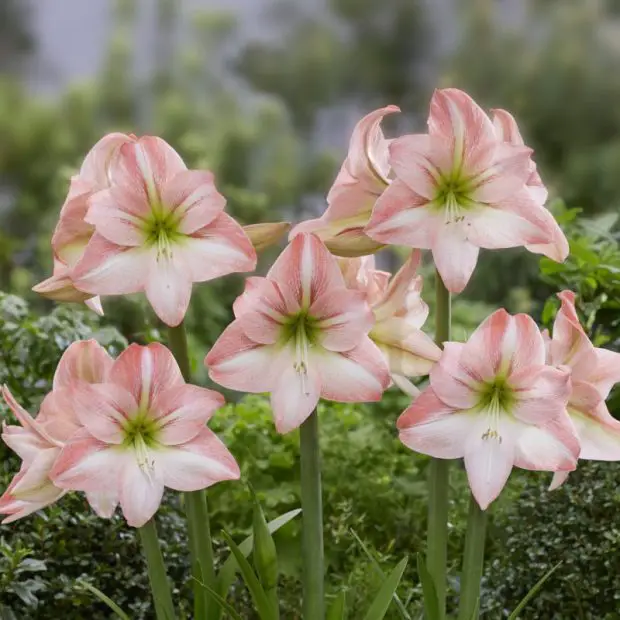Amaryllis is one of the most stunning winter bloomers, lighting up indoor spaces with its bold, trumpet-shaped flowers just when the garden sleeps. But once those show-stopping blooms fade, many gardeners are left wondering—will it bloom again, and if so, when?
Unlocking the secret to repeat flowering isn’t just about waiting—it’s about knowing exactly how to care for your amaryllis after its first bloom. With the right strategy, this beautiful bulb can burst into color not just once, but year after year. Ready to discover how? Let’s dive into the timing, techniques, and tips that will bring your amaryllis back to life.
Understanding the Natural Bloom Cycle of Amaryllis

Initial Blooming After Planting
Amaryllis typically bloom 6 to 10 weeks after planting, depending on the variety and conditions. When purchased as a bulb, they are often forced to bloom indoors during the winter holiday season. This bloom period may fall between December and February if planted in early winter. These initial flowers are supported by the energy stored in the bulb from the previous growing season.
In optimal indoor conditions—warm temperatures (around 70°F or 21°C) and bright indirect light—the flower stalk will emerge first, followed by a cluster of two to six trumpet-shaped blooms. Once the flowers open, they can last up to three weeks, creating a stunning focal point indoors. If multiple bulbs are planted in succession, you can enjoy continuous blooming through the entire winter season.
Dormancy and Rest Period
After blooming, amaryllis enters a dormancy phase. This natural rest period is essential for future blooming. The leaves may remain green for several months to photosynthesize and recharge the bulb. As the months progress, the plant gradually slows down and the leaves will yellow and die back. This rest phase typically occurs in late summer or early fall, lasting around 8 to 12 weeks.
To ensure a healthy dormancy, reduce watering significantly once the leaves begin to yellow. Allow the soil to dry out completely, and place the bulb in a cool, dark location (around 50–55°F or 10–13°C). Avoid fertilizing during this period. Skipping or shortening the dormancy phase can result in weak blooms or no flowering at all in the following cycle.
Reinitiation of the Bloom Cycle
Once the dormant period ends and proper care resumes, amaryllis can bloom again. Most reblooming cycles are timed to occur between late winter and early spring, though this depends on how and when you initiate dormancy and regrowth.
To restart the cycle, bring the bulb back into a warm, bright environment and begin watering sparingly until growth resumes. As new leaves or a flower stalk appear, increase watering slightly and resume light fertilization every 2–4 weeks with a balanced liquid fertilizer. With consistent care, healthy bulbs can rebloom annually, and in some cases, even produce two flowering stalks in one season.
Factors That Influence Reblooming Time
Timing of Dormancy
The dormancy period acts as a biological reset for amaryllis, allowing the bulb to rest and store up energy for future flowering. Starting dormancy too early—before the bulb has replenished itself—can reduce bloom size or prevent flowering altogether. Conversely, extending dormancy too long may weaken the bulb’s internal rhythm, delaying or even disrupting the bloom cycle. To encourage timely reblooming, begin dormancy only after the leaves have yellowed and naturally died back, signaling that the bulb has finished photosynthesizing and storing nutrients.
Temperature and Light
Maintaining consistent warmth and sufficient light is critical once the dormancy phase ends. Temperatures below 60°F may delay growth or cause the bulb to remain inactive, while excess heat without light can lead to tall, weak stems. Ideally, place the pot in a bright room where it receives indirect sunlight for 6 to 8 hours daily. Avoid direct harsh rays that could scorch new growth. Supplementing natural light with grow lights can help maintain strong, balanced growth, especially during winter reblooming indoors.
Nutrient Reserves in the Bulb
A robust bulb is like a battery—its capacity to bloom depends on how well it was charged during the previous growing season. After the flower fades, it’s crucial to feed the plant with a balanced liquid fertilizer (such as 10-10-10 or 20-20-20) every two to four weeks until the leaves die back. This process helps the bulb accumulate essential nutrients. Failure to fertilize properly, especially after blooming, often leads to small or flowerless regrowth cycles. A plump, heavy bulb is a sign of sufficient reserves and a high chance of successful reblooming.
Watering Schedule
Strategic watering at each growth stage is key. During dormancy, the bulb should be kept almost dry—just enough to prevent desiccation. Once new growth appears, increase watering gradually, keeping the soil evenly moist but not soggy. Consistent overwatering, especially in poorly draining pots, can cause bulb rot and hinder reblooming. On the other hand, insufficient watering during the active phase may result in weak leaves and flower stalks. Using a moisture meter or simply checking the top inch of soil before watering can prevent most common watering issues.
How to Trigger Amaryllis Reblooming
Post-Bloom Care to Prepare for Reblooming
While it’s tempting to discard the plant after the blooms fade, this stage is when the amaryllis bulb begins preparing for its next flowering cycle. Leave the green leaves intact and place the pot in a sunny indoor location or even outdoors in filtered sunlight if temperatures allow. Photosynthesis during this time is essential, as it replenishes the bulb’s internal reserves. If leaves appear limp or yellow prematurely, it may indicate inadequate light or overwatering. Monitor closely and adjust conditions accordingly. A thriving leaf system ensures your bulb stores enough carbohydrates to support a strong future bloom.
Inducing Dormancy at the Right Time
Timing is everything when it comes to dormancy. Begin gradually tapering off watering around 10 to 12 weeks before your desired bloom window. For example, if you want flowers by Christmas, start reducing water in early September. It’s essential not to force dormancy too soon, or the bulb may not have enough energy to rebloom. Once dormant, keep bulbs in a breathable container like a paper bag or loosely packed box with peat moss or dry soil. Ensure good air circulation to prevent mold or rot. Avoid storing bulbs in places with fluctuating temperatures or high humidity, such as kitchens or bathrooms.
Reintroducing Light and Water for Blooming
After dormancy, inspect the bulb before potting. Discard any that are soft, moldy, or shriveled. Plant the bulb with its top third exposed in fresh, well-draining potting mix. Position the pot in a bright, warm location — a south-facing window is ideal. Begin watering sparingly until new growth is visible, then gradually increase the frequency. Don’t fertilize until green shoots are well established. If the bulb was properly rested and recharged, you’ll notice a thick flower stalk emerging within 4 to 6 weeks. For best results, rotate the pot occasionally to encourage straight, upright growth.
Seasonal Blooming Schedule Based on Dormancy Timing
Fall Dormancy for Late Winter Bloom
Inducing dormancy in early to mid-September is ideal if you want your amaryllis to bloom during the festive season. Begin by reducing watering and placing the plant in a cool, dark area with temperatures around 10–15°C (50–59°F). This mimics natural dormancy conditions. Keep it dormant for at least 8 to 10 weeks, then bring it back into bright light and resume watering in late November. With proper warmth and care, you can expect striking blooms to appear between late December and early February—just in time for Christmas and New Year displays.
This timing is especially popular for those who want a cheerful splash of color during the darkest part of the year or wish to give blooming amaryllis as holiday gifts.
Winter Dormancy for Early Spring Bloom
To achieve a fresh flush of amaryllis flowers in late winter or early spring, allow the plant to enter dormancy in mid-November. This is particularly effective for households in colder climates where indoor gardening is a priority after the holidays. Keep the bulb in dormancy until early to mid-January, maintaining cool and dry conditions.
Once reintroduced to warmth and water, the plant will sprout and bloom within 6 to 8 weeks, typically by February or March. This schedule brings color when most gardens are still dormant, offering a welcome preview of spring. It’s also a great way to stagger bloom times if you own multiple bulbs.
Customizing Bloom Time for Special Occasions
With careful planning, you can synchronize amaryllis blooms to coincide with any date that holds personal significance. To do this, determine your target bloom week—whether it’s a wedding anniversary in March or a loved one’s birthday in June—and count backward about 10 to 12 weeks. That’s when you should begin dormancy.
For instance, to have a bloom ready by mid-March, you’d start dormancy in early December. Make sure to mark your calendar and adjust light, water, and temperature accordingly to trigger dormancy at the right time. This strategy works best with healthy, mature bulbs that have gone through at least one full annual growth cycle.
Troubleshooting Common Reblooming Challenges
Fall Dormancy for Late Winter Bloom
When you initiate dormancy in early fall—typically around September—and maintain it through November, your amaryllis bulbs are primed to bloom between late December and February. This schedule is ideal for bringing festive color indoors during the winter holidays. The cool weather and shorter daylight hours naturally support the bulb’s rest period, setting the stage for a strong rebloom. With the right temperature control and darkness, you can reliably trigger a flush of vibrant flowers just as winter sets in.
Winter Dormancy for Early Spring Bloom
If you delay dormancy until November and keep the bulbs dormant through January, you can expect blooms from February to April. This timing is perfect for those who want their amaryllis to signal the beginning of spring. As days lengthen and indoor light increases, your plants respond with strong growth and striking blossoms. Aligning dormancy with the colder winter months makes it easier to maintain the low-light, cool temperatures that amaryllis require during rest.
Customizing Bloom Time for Special Occasions
With a bit of planning, you can customize your amaryllis to bloom for almost any special event. Whether you’re aiming for Valentine’s Day, an anniversary, or a loved one’s birthday, the key is to count backward 10 to 12 weeks from the desired bloom date. That’s when you should begin dormancy. For example, if you want flowers to open in mid-March, start the rest period around late December. This level of control makes amaryllis one of the few flowering plants that can be timed so precisely, adding joy and beauty to meaningful moments year-round.
Long-Term Strategy to Keep Amaryllis Blooming Year After Year
Consistent Annual Dormancy Is Crucial
Amaryllis needs a reliable period of rest each year to recharge its energy for future blooming. This dormancy phase mimics the plant’s natural cycle in its native climate and is essential for flower bud formation. Without it, the plant may continue to grow leaves but won’t produce blooms. To maintain consistent annual dormancy, reduce watering in late summer and place the plant in a cool, dark place (10–15°C or 50–60°F) for 8–12 weeks. Monitor the bulb during this time to ensure it doesn’t rot, and resume watering only when new growth appears.
Replenish Soil Nutrients After Each Bloom Cycle
Flowering drains essential nutrients from the bulb and soil. After blooming ends and new foliage begins to grow, it’s critical to feed your amaryllis with a balanced, water-soluble fertilizer—ideally one high in phosphorus (like 10-30-20) to support future blooms. Apply fertilizer every two to four weeks during the growing season, typically spring through summer. Additionally, consider repotting the bulb every 2 to 3 years using fresh, well-draining potting mix to avoid soil compaction and nutrient depletion. A slightly snug pot promotes blooming by keeping the bulb somewhat root-bound.
Allow Full Leaf Growth Before Forcing Dormancy
Healthy, vigorous leaves are the primary source of energy that the amaryllis bulb stores for the next bloom cycle. That’s why it’s crucial to let leaves grow freely after flowering—do not cut them back prematurely. Continue watering and feeding the plant during this period so that it can photosynthesize efficiently. Only initiate dormancy after the leaves begin to yellow naturally or in late summer/early fall, depending on your desired blooming window. Cutting the leaf cycle short can weaken the bulb and reduce the chances of successful reblooming.
Rotate Indoor and Outdoor Growing
To maximize bulb strength, take advantage of both indoor and outdoor environments throughout the year. After the danger of frost passes in spring, move your amaryllis outside to a semi-shaded area. The exposure to natural light and warmer temperatures will encourage robust leaf growth and strong bulb development. Bring the plant indoors before the first fall frost and start preparing for dormancy. This rotation mimics the plant’s native growing conditions and contributes to healthier bulbs that bloom more reliably over the long term.
Frequently Asked Questions About Amaryllis Reblooming
How often should I repot my amaryllis to keep it blooming regularly?
You should repot your amaryllis every 2 to 3 years to refresh the soil and provide enough nutrients for continued growth. Choose a pot that is just slightly larger than the bulb, and always use a rich, well-draining potting mix. Ensure the top third of the bulb stays above the soil line to prevent rot and support healthy development.
What is the best fertilizer schedule for amaryllis after it finishes blooming?
After blooming, feed your amaryllis every 2 to 4 weeks with a balanced liquid fertilizer (such as 10-10-10 or 20-20-20) during the leaf-growing phase. This helps the bulb store enough energy for the next blooming cycle. Stop fertilizing once the leaves start yellowing and the plant enters dormancy.
Can I leave my amaryllis outside year-round?
Amaryllis can be placed outdoors during late spring and summer, but only in climates where temperatures remain above 10°C (50°F). Choose a partially shaded spot to prevent sunburn. Before temperatures begin to drop in early fall, bring the plant indoors to begin the dormancy cycle. Never expose it to frost.
How do I know when my amaryllis is ready to go dormant?
When the leaves naturally turn yellow and begin to die back, the bulb is signaling that it’s time to rest. Stop watering completely, cut back the dead leaves, and place the bulb in a cool (10–15°C or 50–59°F), dark place for 8 to 12 weeks. This rest period is critical for encouraging reliable re-blooming.
What should I do if my amaryllis isn’t reblooming after dormancy?
If your amaryllis doesn’t rebloom, it may not have stored enough energy during the previous growing season. Make sure it received enough sunlight, was fertilized regularly, and had a proper dormancy period. Restart the cycle with strong leaf growth in spring, and you should see blooms in the next season. Patience and consistent care are key.
Conclusion: Unlocking Repeat Blooms With Careful Timing and Routine
Amaryllis reblooming isn’t just a matter of luck—it’s a result of attentive care, seasonal planning, and understanding the plant’s natural rhythms. By allowing a full growing season, inducing proper dormancy, and restarting growth at the right time, you can enjoy these stunning blooms year after year. Whether you aim for winter color or spring brilliance, the secrets to amaryllis reblooming are within your reach. With consistency and care, your amaryllis will reward you with dazzling flowers that brighten any space and season.






